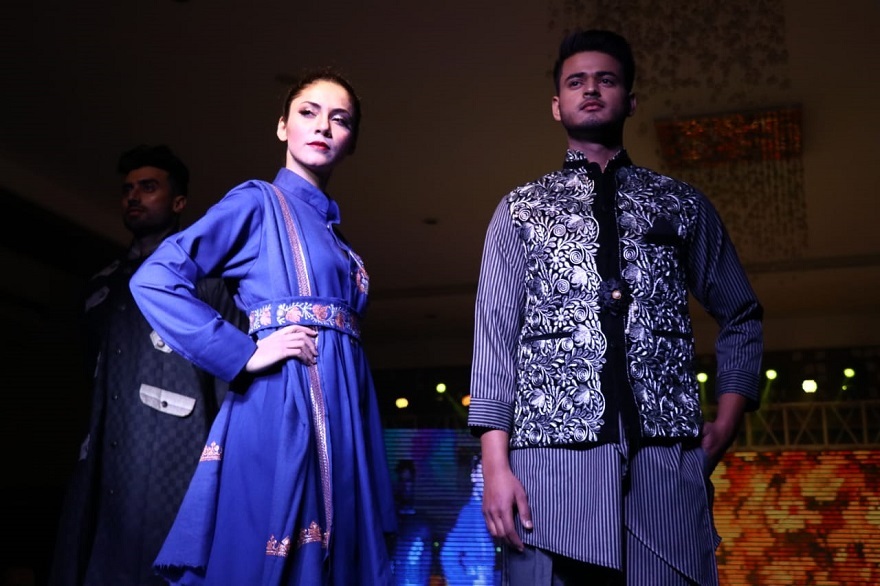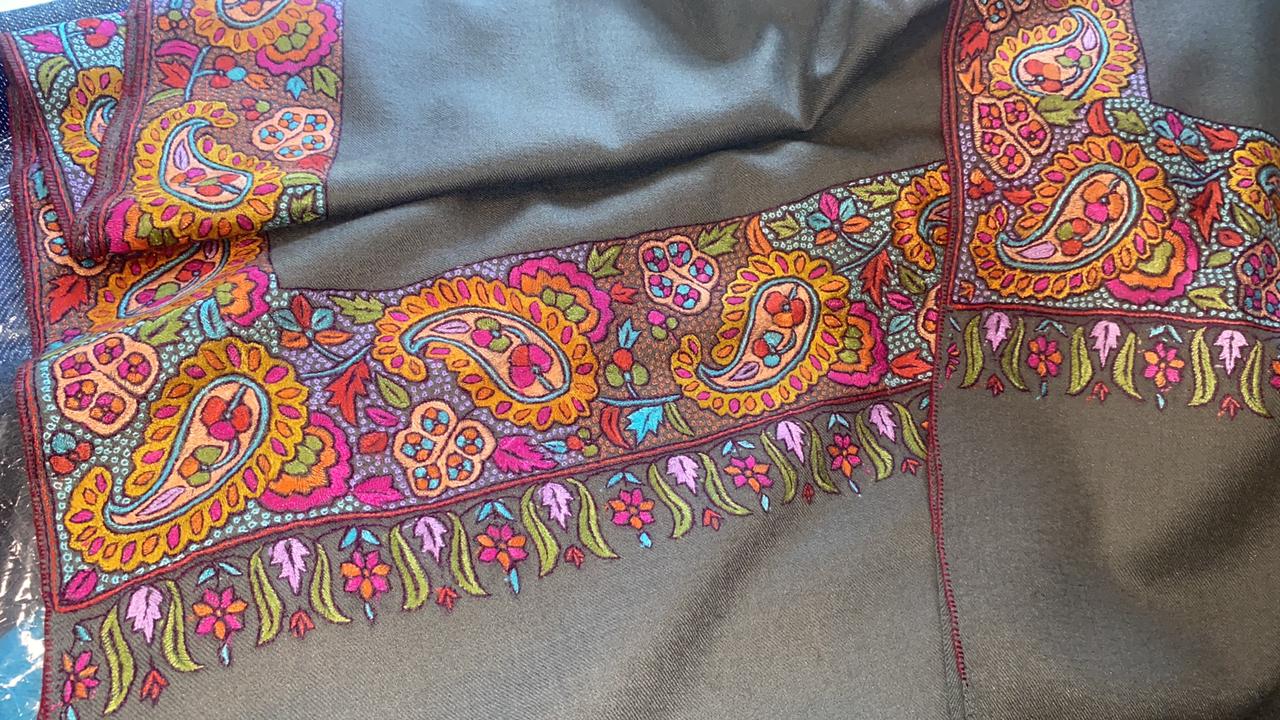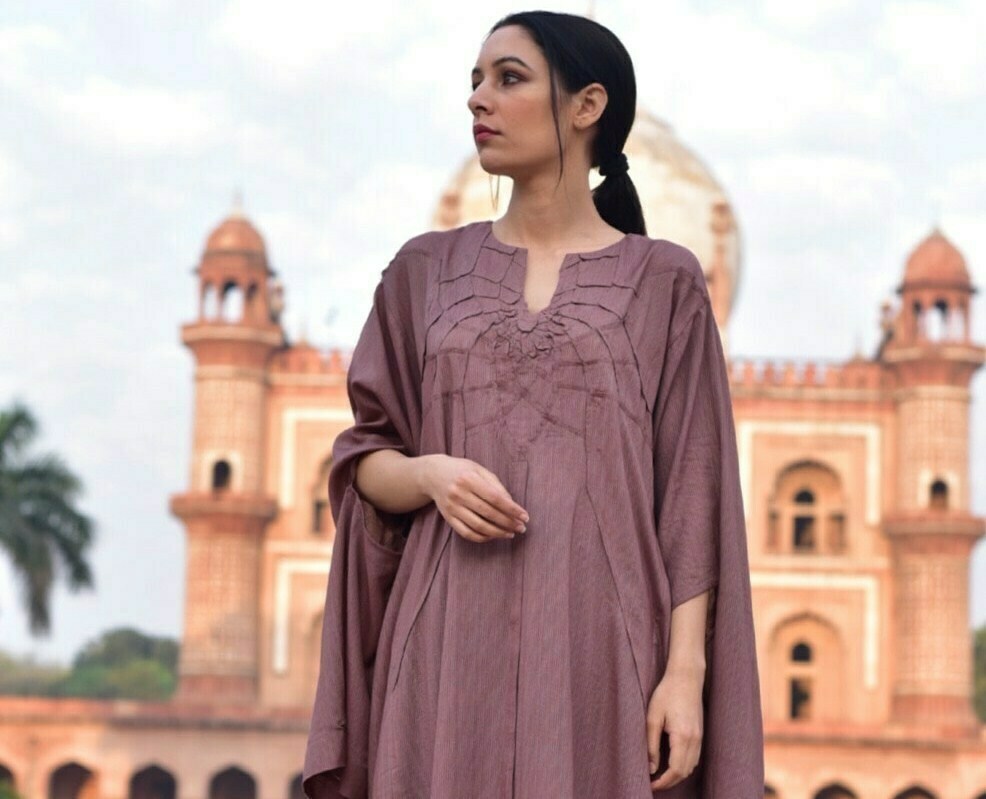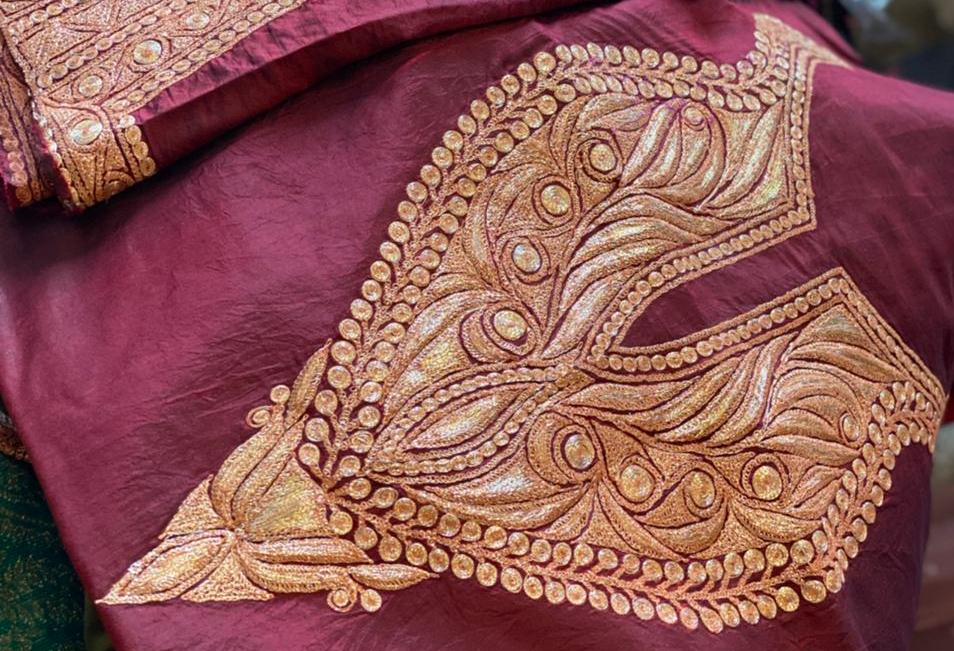
Art and craft practices in Kashmir are not only markers but also the result of political, cultural, and artistic exchanges with erstwhile Persia and beyond. Over the past few centuries, these crafts have absorbed local tradition, resulting in a visual vocabulary that is Kashmir’s own.
By Shubhanjana Das
AMJID Gulzar sits in the shop his great-great-grandfather established in 1842 as a tailoring store for the British elite living in houseboats by the Bund in Srinagar. His ancestors have catered to dignitaries around the world in custom-made bespoke suits, pherans, and shawls made in fine embroidery, among others, establishing the trusted craftsmanship of Kashmiri artisans.
The store, K. Salama has evolved over the years as a one-stop destination for tourists as well as locals for Kashmiri clothing.
What is commonly perceived as ‘Kashmiri clothing’, most popularly the pheran, pashmina and shahtoosh shawls (which are now banned), is the coalescence of multi-cultural influences mapping its history.
Art and craft practices in Kashmir are not only markers but also the result of political, cultural, and artistic exchanges with erstwhile Persia and beyond. Over the past few centuries, these crafts have absorbed local tradition, resulting in a visual vocabulary that is Kashmir’s own.
The third generation of the handicrafts dynasty of Suffering Moses, Muzaffar Sadiq’s familial history is a case in point. He recounts that his ancestors were brought from modern-day Iran to the Kashmir Valley at the mandate of the 13th century Muslim saint-reformer Shah-i-Hamdan and then the 15th century emperor known as Badshah (Sultan Zain-ul-Abidin) to teach the locals the finer handicrafts of papier-mâché and wood carving.
Along with similarities in the linguistics, architecture, literature, art, cuisine, and the cultural traditions, the sartorial resemblance with Iran is also prominent.
“It is for these and other cultural influences that Kashmir is often termed as the Iran-e-Saghir in the academic parlance,” states Prof. Mushtaq A. Kaw, Former Director, Centre of Central Asian Studies and Dean College Development Council, University of Kashmir.
“The Kashmiri dress has the Afghan, Bukharan and Iranian influence. However, it is distinguishable by needle, stitch or embroidery works of various sorts, motif and floral designs.”

Traditionally, the kurta-salwar, made of wool, cotton and silk, resembling an Afghani Khan dress, layered with a woollen-cotton made pheran, going from the neck down to the knees, besides a Kashmiri pashmina or tus shawl spread over the shoulders and a skull-cap constituted the men’s dress.
For women, it was salwar-kameez made of wool, cotton and silk, designed with intricate embroideries, donned with a woollen-cotton made pheran, besides a dupatta or head-scarf called kasaba in Kashmiri, and a pashmina or tus shawl worn over the shoulders, notes Prof. Kaw.
Besides giving warmth, the pheran is roomy enough for the kangri, a winter essential, which generates additional heat to the body against chilly winters.
Sadiq points that the 8-9 months long extreme winter isn’t the only natural influence on Kashmir’s clothing traditions; the motifs used by karigars in papier-mâché and wood-carving as well as on textiles borrow heavily from the valley’s biotic elements.
Along with the omnipresent paisley, gulaab (rose), pamposh (lotus), the kingfishers of the Dal Lake, and the Chinar leaves are some of the most recognisable motifs embroidered on Kashmiri clothing.
The founder of design house Raffughar, Wajahat Rather, notes how some artisans would refer to a certain colour scheme as ‘harud’, meaning ‘autumn’ in Kashmiri, indicating “how they follow and harmonise colours by looking at nature. They never get it wrong”.

The climatic conditions in Kashmir also dictated the fabrics that were predominantly produced locally. While cotton cultivation was not productive due to its poor yield, extensive green regions provided an adequate grazing ground to sheep. As a result, wool was produced in a much larger ratio.
Beside this, there were abundant mulberry trees in the areas of Kishtwar whereupon silk worms were raised upon the mulberry tree’s leaves. Presently, the majority of the fabrics used in Kashmir are made in mills, imported from different parts of India, as well as outside the country.
The luxurious and super-fine pashmina, raffel, and silk, however, continue to act as canvases for the painstaking embroidery practiced by Kashmiri karigars such as kashida, sozni, kani, and aari, among others.
One of these embroidery forms now coveted world over is the exquisite and exclusive tilla embroidery done on pherans using gold and silver metallic threads, a wedding trousseau essential for every Kashmiri Muslim bride.
However, Gulzar notes that tilla is now getting a contemporary spin for everyday wear. “5 out of 10 clients are asking for tilla embroidery nowadays, be it in their stoles, scarves, or kurtis in silk, georgette, crepe, or velvet,” he says.

Gulzar also notes that an increasing share of his local clientele now opts for made-to-measure clothing in traditional textiles but contemporary silhouettes over readymade ensembles.
Designer and stylist Shahid Rashid Bhat, whose designs are heavily informed by Kashmir’s nature and its rich artistic history, agrees that contemporisation is key in order to sustain certain embroidery and clothing traditions of Kashmir.
He, too, observes that “the youth of Kashmir wants to amalgamate the old and the new. They want to flaunt Kashmiri traditions, but with a contemporary twist.”
From using traditional embroidery outside shawls and the salwar kameez to rethinking the silhouette of the pheran for the modern clientele, there are multiple innovative design opportunities that contemporary Kashmiri designers are now exploring, albeit on the foundation of its perdurable artisanry.

For Wajahat Rather, the traditional pheran itself championed modern sartorial trends like sustainability, zero-waste, androgynous designs, and relaxed fits.
“Even though this vocabulary was not there, pheran was all this, even when the fashion world wasn’t talking about it,” he says.
He also goes back to the pheran as well as the enduring embroidery forms of Kashmir for his collections with an effort to innovate them.
Both Rather and Bhat echo that even in the face of rampant mechanisation and replication in the handicrafts industry, the intricacy, quality, and durability of embroideries and art forms done by hand will continue to remain inimitable and coveted around the world.
“Kashmiri handmade fabric has been sustaining despite the Industrial Revolution in the past and free market economy in the present,” observes Prof. Kaw.
“It shall sustain in future too, depending upon the availability of local raw material, climatic changes, economic affordability and competitive capacity of the Kashmiri fabric in use and demand outside.”
Follow this link to join our WhatsApp group: Join Now
Be Part of Quality Journalism |
Quality journalism takes a lot of time, money and hard work to produce and despite all the hardships we still do it. Our reporters and editors are working overtime in Kashmir and beyond to cover what you care about, break big stories, and expose injustices that can change lives. Today more people are reading Kashmir Observer than ever, but only a handful are paying while advertising revenues are falling fast. |
| ACT NOW |
| MONTHLY | Rs 100 | |
| YEARLY | Rs 1000 | |
| LIFETIME | Rs 10000 | |










